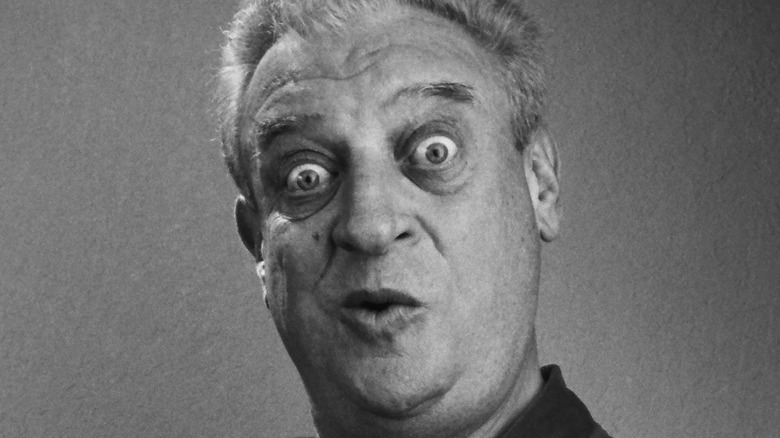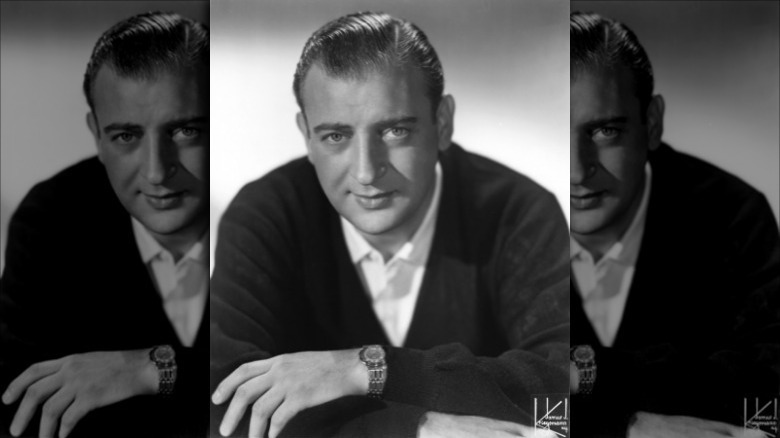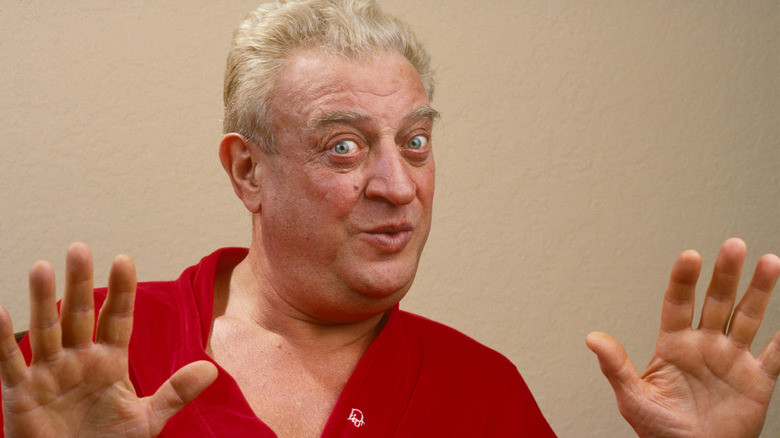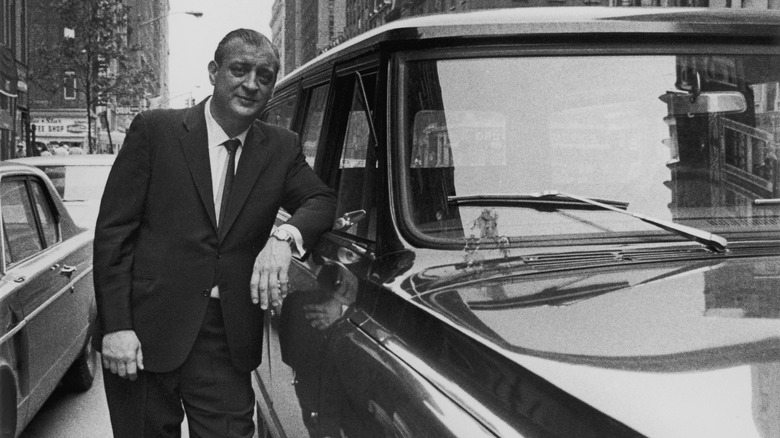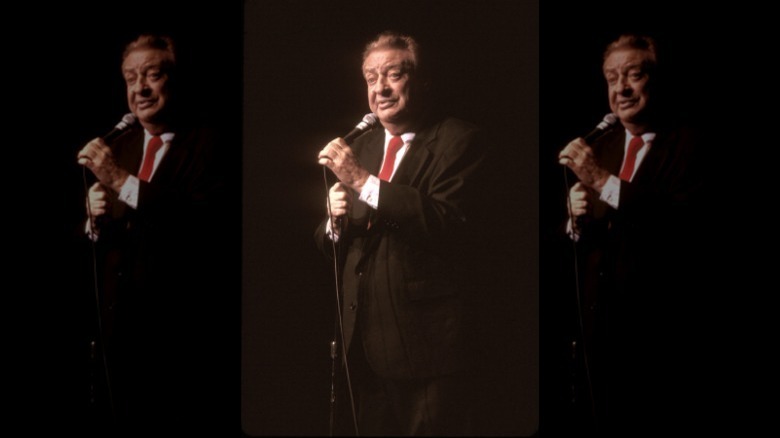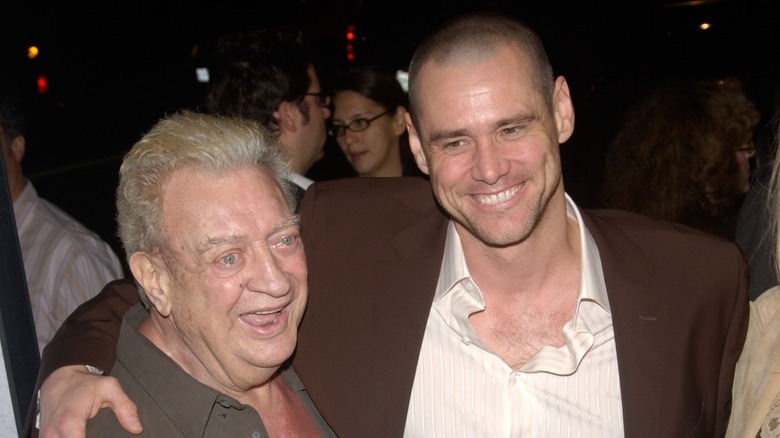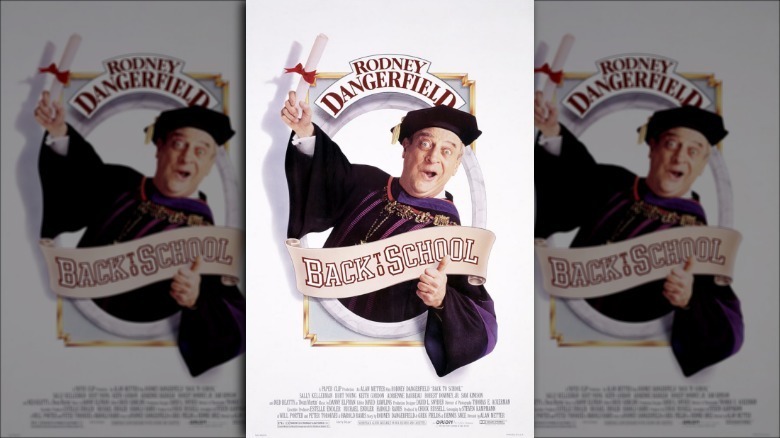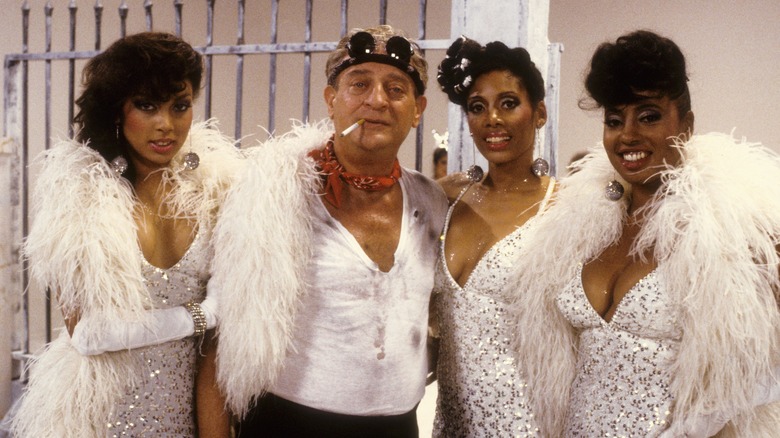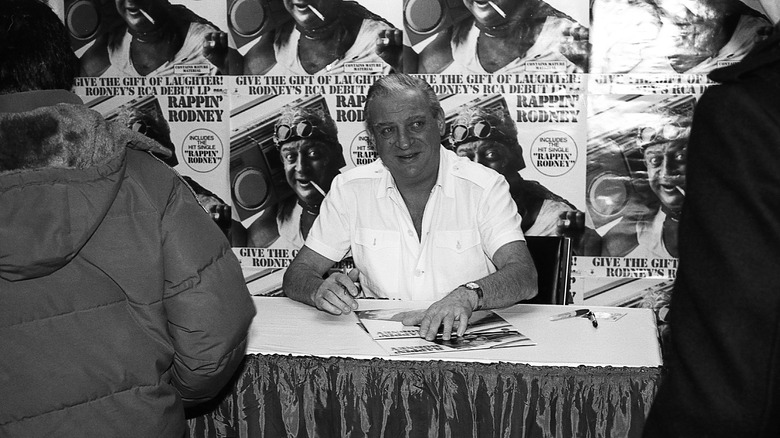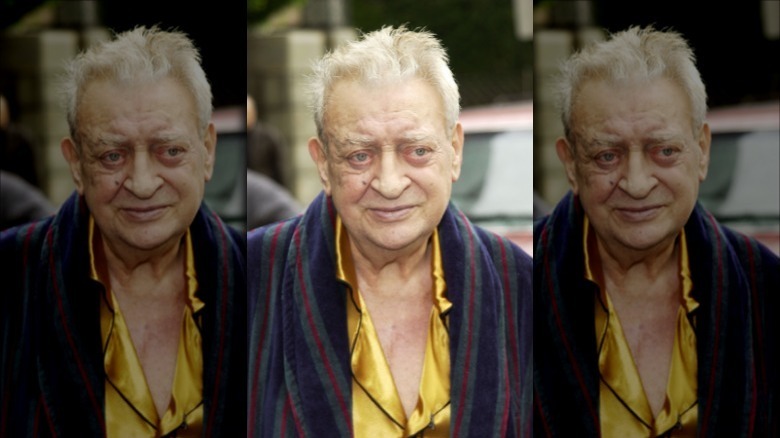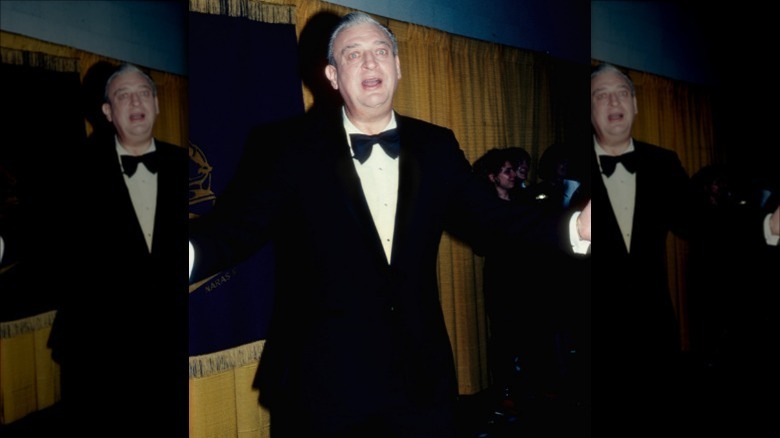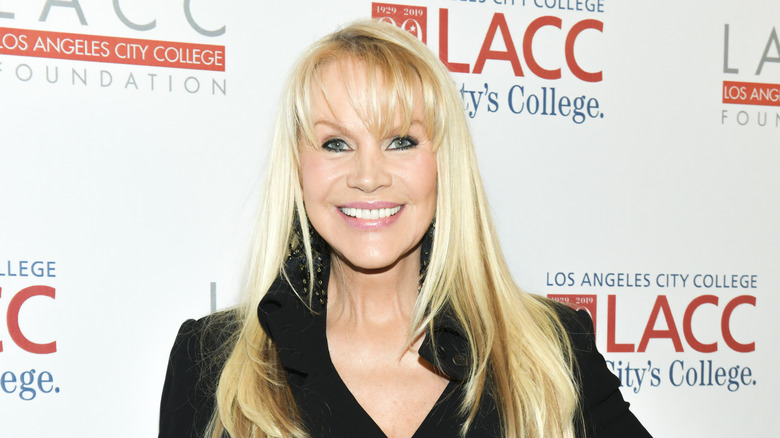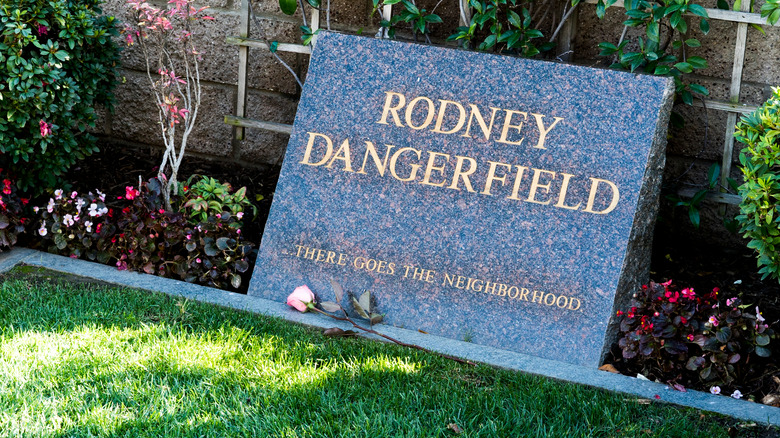The Untold Truth Of Rodney Dangerfield
Rodney Dangerfield remains one of the most recognizable faces and voices in pop culture. His comic persona as a miserable, set-upon everyman who got "no respect" was something that every member of his audience could relate to. Dangerfield somehow achieved the impossible: He made being an unhappy, middle-aged man somehow cool and hip. He also made an old-school style of stand-up comedy with roots in the Borscht Belt and vaudeville into an ultra-modern, carefully calibrated routine that was honed into a series of diamond-like one-liners.
Those one-liners were the secret: They were consistently hilarious. When Dangerfield said, "I could tell that my parents hated me — my bath toys were a toaster and a radio," or "I worked in a pet store and people kept asking how big I'd get," he tapped into a deep well of self-loathing that had everyone in stitches.
But that self-loathing and sadness wasn't an act. Rodney Dangerfield was a perfect example of the old adage that comedy is tragedy plus time. Although the sweaty sad-sack he presented on stage was a carefully-constructed persona that he honed over the course of decades, Dangerfield's life was more complex than most people know. Here is the untold truth of Rodney Dangerfield.
Rodney Dangerfield grew up poor and unhappy
On stage, Rodney Dangerfield made frequent jokes about his unloving mother and his miserable childhood. As it turns out, those jokes were based on a very real, very miserable childhood.
According to Biography, Dangerfield was born Jacob Cohen in Babylon, New York in 1921. His father, Phil Roy, was a performer on the vaudeville circuit, juggling and telling jokes. Roy abandoned the family soon after Dangerfield's birth. That left him to be raised by his mother, whom The New York Times reports "withheld affection and kindness," making him feel unwanted at a very young age. According to The Spokesman-Review, his mother often made "cruel remarks" that made her lack of love for him very clear. And, according to Dangerfield's widow Joan, his mother once suggested he open a savings account to put away money for a football uniform — then stole the money for herself.
Dangerfield moved with his family to Queens when he was still a very young child, and he experienced antisemitism from his classmates — as well as his teachers (via Biography). On top of everything else, because his father had left, Dangerfield had to go to work as a child, selling ice cream, making deliveries, and even driving a fish truck just to keep food on the table. One thing is for sure — when Dangerfield once said he would choose a "different mother, different father, different sister, different everything," he wasn't joking.
He was taken advantage of as a child
Rodney Dangerfield grew up poor and had to work a long list of odd jobs to help support his family. Back in the 1920s and 1930s when Dangerfield was growing up, a nickel was a lot of money — and that led to one of the saddest stories of Dangerfield's childhood.
Biography notes that Dangerfield was, more or less, totally unsupervised as a child. When he was as young as 5 years old he took to wandering his neighborhood. According to Dangerfield's autobiography "It's Not Easy Bein' Me," on one of these walks, he was approached by a man who offered him a nickel to sit on his lap. Dangerfield happily agreed. He sat on the man's lap — and the man held him and kissed him on the lips for several minutes.
Unaware of what was happening, Dangerfield returned to the man's office many times to get another nickel. Although he jokes that this made him a "male hooker" at the age of 5, he closes the anecdote with a bitter admonition: "Thanks for lookin' after me, Ma." When asked years later about the impact of that incident, Dangerfield admitted that "I could have come out being a nasty person," but somehow things went the other way.
If you or anyone you know has been a victim of sexual assault, help is available. Visit the Rape, Abuse & Incest National Network website or contact RAINN's National Helpline at 1-800-656-HOPE (4673).
Rodney Dangerfield failed hard at first
As noted by Biography, Rodney Dangerfield's father was in show business, performing as a juggler and comic. Although Phil Roy abandoned his family shortly after his son was born, Dangerfield found himself following in his father's footsteps. According to Rolling Stone, Dangerfield began writing jokes when he was just 15 years old, and he speculates that it might have been a way to escape the crushing depression of his childhood. He worked hard, getting a gig working in the Catskills for a summer, but then hit a professional wall.
In his autobiography "It's Not Easy Bein' Me," Dangerfield writes that he gave up when he was 28 years old. He was tired of the endless travel and the pressures of not quite succeeding in show business. He got married to singer Joyce Indig, who also gave up her career aspirations to start a family. Dangerfield took a job selling aluminum siding and paint, and settled into what he describes as a "normal life." According to NBC News, he was so unsuccessful as a comedian that he "was the only one who knew [he] quit."
But Dangerfield never stopped writing jokes. And he soon discovered that two people giving up their dreams and starting a family didn't necessarily make for perfect happiness. As his marriage failed, he returned to performing, past 40 and still unknown. According to ABC News, when he re-launched his career, he still couldn't get booked — and was soon $20,000 in debt.
He made it big in middle age
Rodney Dangerfield's career was unusual in many ways. One of the most surprising facts is that he was nearly 50 years old when he finally found success as a comedian (via ABC News). In fact, according to The New York Times, Dangerfield didn't hit his professional peak until he was nearly 60 years old.
As noted in the book "Make 'em Laugh!," Dangerfield had given up on comedy after failing to gain any traction in the 1940s. He got married when he was 28 years old and stayed out of the business for more than a decade, working as an aluminum siding salesman. After divorcing his first wife in 1961 at age 40, Dangerfield decided to give show business another chance.
He struggled for a while. But that struggle led him to perfect what would become his persona — an unhappy, put-upon middle-aged man who got "no respect." Armed with a clear persona that everyone in his audience could relate to, and trimming his jokes down until they were nothing more than setup and punch line (he once said he would work for three months on six minutes of material), he began to find success. As he writes in his autobiography "It's Not Easy Bein' Me," in 1963, he landed an audition to appear on "The Ed Sullivan Show" — and aced it. He became a regular on the show and began appearing on other TV shows.
Rodney Dangerfield opened his own club to avoid travel
In 1969, Rodney Dangerfield's career was picking up steam, but he was still just a working comedian — not a superstar. As noted in Rolling Stone, Dangerfield had two children and a complicated marriage. All the travel and pressure of showbiz was taking it's toll. So, despite his relatively recent success, Dangerfield decided to open his own club. He had to borrow $250,000 in order to do it.
According to the book "Make 'em Laugh!," Dangerfield's became known in the industry as a place where young, unknown comedians could get a toehold in the business. Rodney Dangerfield was not only well-known for his support of young comedians, he also used the club as the venue for a series of HBO specials that helped launched comics such as Jerry Seinfeld, Roseanne Barr, and Jim Carrey. As noted by The Hollywood Reporter, Dangerfield's operated for more than 50 years, finally closing in 2020 due to the pressures of the COVID-19 pandemic and associated lockdowns. The club became a legendary place to experience comedy — so iconic it was used in 2019's "Joker" as the location where Arthur Fleck bombs miserably as a stand-up, according to Vulture.
The club was so successful Dangerfield was able to pay back his investors just a year and a half after opening, and, as of 2020, the club's owner intends to re-open at a new location.
TV and movies made him A-List
In the mid-1970s, Rodney Dangerfield had achieved what had once seemed impossible. The man who'd quit the business for ten years and re-launched his career in his 40s was a star. He appeared regularly on late-night television and had a steady string of sold out, live performances. But he wasn't yet a superstar.
For that, he needed prime-time screen time. First came a series of comedic commercials for Miller Lite beer. The first of these ensemble ads aired in 1977, and featured a mix of athletes and other celebrities — including Dangerfield. According to The New York Times, by 1981, they'd filmed more than 70 of the commercials, many of which featured Dangerfield doing his classic "no respect" schtick.
In 1980, Dangerfield had his second major film role (he'd appeared in the obscure 1970 film "The Projectionist") playing obnoxiously noveau-riche Al Czervik in "Caddyshack." As noted by WPTV, this was Dangerfield's breakout role and elevated him to true star status. Three years later, he appeared in his first starring tole in "Easy Money," and three years after that, he starred in "Back to School," which was a massive hit — ABC News reports it was one of the first comedies to earn more than $100 million at the box office. Dangerfield was 65 years old and finally a superstar.
He was (sort of) a rap pioneer
Kids today grew up not knowing about "Rappin' Rodney," and it shows. Today's hit music is infused with hip hop and rap, but back in the early 1980s rap music struggled to get mainstream attention. As noted by MTV, the first rap video to ever air on the network was "Rapture" by Blondie — not exactly an authentic example of the genre. The second rap video to air on MTV? Why, that would be "Rappin' Rodney" by Rodney Dangerfield.
As Vulture points out, the early 1980s hip-hop was a "fringe genre" of music — especially to older white folks listening to the radio. A novelty song like "Rappin' Rodney" was the only real hope to hear rap on the radio. And the song has some real, actual hip-hop cred — according to The New York Times, it was produced by J.B. Moore and Robert Ford Jr., who produced much of legendary rapper Kurtis Blow's early work.
The song might be a novelty, but it contains some of Dangerfield's classic comedy lines — and was a bona-fide hit, reaching #83 on the Billboard chart, where it spent eight weeks. It also earned Dangerfield his second Grammy Nomination for Best Comedy Recording (he won in 1980 for his album "No Respect"). Once again, Dangerfield's canny use of the visual medium — in this case, the rising power of MTV — boosted his star power.
Rodney Dangerfield was badly injured by a steam bath
By 1988, Rodney Dangerfield was a big star. His star vehicle "Back to School" had been a huge hit, one of the first comedy films to crack $100 million at the box office (via ABC News). He was also in-demand in Las Vegas, where AP News reports he'd appeared close to 1,000 times by March 1988.
That streak ended, however, when Dangerfield had an accident with a malfunctioning steam bath at Caesar's Palace, where he'd signed a contract to perform. According to TulsaWorld, Dangerfield missed five shows as a result of eye injuries. When he learned that Caesar's was withholding his fee for those five shows as a result, he walked out of a packed house, telling the audience to get their money back.
According to the Los Angeles Times, the lawsuits started flying. Dangerfield sued, seeking $5 million plus $45,000 for each of the five shows he missed, blaming the hotel for installing a faulty steam bath. Caesar's Palace counter-sued for breach of contract, seeking $100,000. The hotel hired a doctor who testified that Dangerfield could have performed, and claimed the comedian had gone out partying when he was supposedly incapacitated. The jury came back in favor of Dangerfield, awarding him $500,000 for pain and suffering and $225,000 for the missed performances. And Dangerfield had the last laugh, signing on to perform at Bally's across the street.
He battled depression his whole life
Many make the mistake of assuming comedians are funny because they're joyful, but the opposite is often true. Rodney Dangerfield is a perfect example: As noted by The Spokesman-Review, the man who made so many people laugh with his self-deprecating humor battled depression his whole life. In fact, he was diagnosed with clinical depression late in life.
The AV Club reports that Dangerfield's early life gave him plenty of cause for depression. His father abandoned his family; his mother was cold and unloving. In his later life, Dangerfield suffered wild mood swings and sometimes stayed in bed all day under the covers, refusing to come out. In his autobiography, "It's Not Easy Bein' Me," Dangerfield writes that the worst depression he experienced occurred when he was in his 70s, saying "It was a bad one. For two years, I couldn't function." He was on a large number of prescriptions, and as his overall health failed, he found himself taking more than a hundred pills a day.
Dangerfield also admits he self-medicated to treat his depression, with both alcohol and marijuana. In fact, Dangerfield loved the latter — he smoked pot every day for 60 years and wanted to title his autobiography "My Love Affair With Marijuana."
He married — and divorced — his first wife twice
Rolling Stone reports that when Rodney Dangerfield was approaching his 30s, his attempts to launch a career in comedy had gone nowhere. When he met a singer named Joyce Indig, he decided to give up his dreams and get married — he was "looking for love," he once said, and craving normalcy. Indig also gave up her singing career.
The marriage was tumultuous — Dangerfield describes it as "a real mixed-up affair." Dangerfield became a father at the age of 39, and the couple had two children, Brian and Melanie. According to Biography the marriage ended shortly after Brian's birth, with the couple divorcing in 1962 after 13 years. The divorce didn't stick, though — Dangerfield married Indig a second time in 1963, only to divorce her again in 1970. He also launched his comedy club in New York City — Dangerfield's — in part to be closer to his family and eliminate the constant travel a comedy career required.
Then, in 1975, Indig passed away, and Dangerfield was left to raise their children by himself (via People.com). Far from the crazy life of a famous person, Dangerfield lived with his kids (and, for many years, his best friend Joe Ancis) in his Manhattan apartment.
His second wife controls his estate
Rodney Dangerfield's love life was kind of messy. Per Fox News he married his first wife, Joyce Indig, in 1949, got divorced in 1962, then married the same woman again in 1963, and divorced for a second time in 1970. Then Joyce passed away in 1975, and Dangerfield remained single for a long time.
Then, as reported by The Spectrum, Dangerfield met a woman named Joan Child when he walked into her flower shop in Santa Monica in 1983. Dangerfield was in town working a fitness program, and the two hit it off almost immediately. They took things slow, however — they dated for a decade before finally deciding to make it official and get married. When they wed in 1993, Joan was 41, and Dangerfield was 72. According to ABC News, when Dangerfield was promoting his 2000 film "My Five Wives," the couple staged a re-commitment ceremony to confirm their devotion.
When Dangerfield passed away in 2004, the couple had been together for more than 20 years, and Joan was given control over Dangerfield's estate and intellectual property. According to Reuters, she hasn't been afraid to sue to enforce that control — even taking her own step-daughter to court over footage of Dangerfield performing. Her attorney asserted "all copyrights to Rodney Dangerfield's act are held by Joan Dangerfield, who owns all of her late husband's intellectual property."
Rodney Dangerfield passed away at 82
Rodney Dangerfield was never much of a health nut. The AV Club reports that he was a heavy smoker most of his life — in his autobiography, "It's Not Easy Bein' Me," Dangerfield admits he would often walk around with three different packs of cigarettes. He struggled to quit, often rewarding himself for going a day without smoking ... by smoking. That combined with a not-particularly healthy diet and a lack of exercise left Dangerfield in fragile health in his later years.
As reported by The Spokesman-Review, Dangerfield suffered a mild heart attack in 2001 while performing on "The Tonight Show" on his 80th birthday — host Jay Leno actually noticed something was off and called paramedics while Dangerfield was on stage. ABC News reports that Dangerfield soon needed a heart bypass — but doctors were concerned about his blood flow, so he first had to undergo brain surgery. He came through that successfully in 2003. Sadly, when he went back to the hospital months later for the heart surgery, he suffered a stroke and then slipped into a coma (via ABC News).
Amazingly, he was brought out of his coma when his wife asked if he wanted to see an X-rated cartoon Dangerfield thought was hilarious (according to his autobiography, the caption was "surprise balloon"). That roused him back to consciousness — but he passed away a few weeks later at the age of 82.
